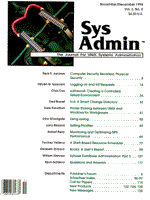
Publisher's Forum
If you've been a subscriber for a while, you'll notice a few changes in this issue. All of them are intended to give you more and better information. First, we've kept the contents listing on the cover, but also replicated it inside. Since we began mailing the magazine without an envelope, we've realized that if your issue arrives with a tattered cover (as some unfortunately do), you'll have no way of knowing the contents. So we're including a table of contents inside the magazine as well, which will also give us room for change #2. This second change is to place online source code availability information right on the new contents page. We've done an amazing job of keeping that information hidden up to now--we've had an entry entitled "Online Source Code" in the Departments section on the cover. On the page referenced there we print a discreet little box, very easy to overlook, containing the code availability information. From now on, the information itself will be right there on the contents page--highlighted. We apologize to all of you who've had to call or email or fax to extract this information from us--we hope the new placement will be more in keeping with everyone's expectations. Change #3 is an expanded advertiser index (you may have noticed the prototype in our Sept/Oct issue). Many of our advertisers are now participating in an automatic information service, called Instant Info, that lets you call in and have information about a product faxed to you on the spot. The advertiser index will now include the Instant Info ID number for participating products, as well as information on how to access the service. Also new is an alternative to the traditional reader's service card: a reader's service email address. Yes, even as we press on to the 21st century, we're panting to keep up with this one! You can still use the traditional means, sending in a reader's service card, if you prefer, but we invite you to join us in this cyberservice adventure. Along with the new items, you'll find some interesting approaches to security from Chris Cox and Neal Jamison, and enlightenment from Betty Zinkann on how to acquire the USENIX/O'Reilly 4.4BSD collection. Bill Genosa tells you more about Sybase administration; Packey Velleca contributes a handy scheduling tool; John Woodgate explores syslog; Robert Berry tells how to monitor and optimize NFS performance; Larry Reznick helps you set priorities; and Fred Brunet gives you a new cd tool (fcd--we think it stands for Fred's change directory). Meanwhile, Bjorn Satdeva weighs in with conference updates and his Q&A; Steve Isaacson shows how to log rm and kill requests; and Dale Panatonni emerges bloody but unbowed from a project that required setting up printer sharing between UNIX and Windows for Workgroups.
Sincerely yours,
|